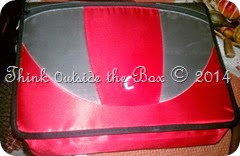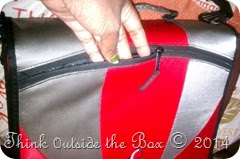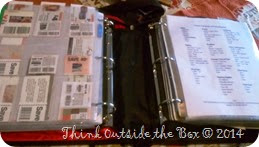2 Corinthians 5:17-18 (KJV)
Therefore if any man be in Christ, he is a new creature: old things are passed away, behold all things are become new.
And
all things are of God, who hath reconciled us to himself by Jesus
Christ, and hath given to us the ministry of reconciliation
Sunday, October 25
Wednesday, October 21
Monday, October 19
Chicken Corn Chowder
Chicken Corn Chowder
Ingredients:
6 strips of bacon
1 medium onion, diced
1 stalk celery, diced
2 carrots, diced
2-4 cloves garlic, minced
2-3 chicken breasts cut into bite-size pieces
4 medium potatoes (2 cups), peeled and diced (sometimes I sub with 2 sweet potatoes)
10.5 oz. low sodium cream of chicken soup
14.5 oz. can creamed corn
1/2 of 16 oz. bag of frozen corn (or 1 can of corn, drained)
1 tsp. salt
1/2 tsp. pepper
1/2 tsp. dried thyme
1 Bay leaf
2 Tbsp. butter
2 cups of chicken broth (or water but it won't be as flavorful)
1/2-1 c. half and half or 12 oz. can of evaporated milk (see note)
2-4 Tbsp. cornstarch (start with a little and add more if needed)
Directions:
Sauté bacon in a skillet until crisp. Drain on paper towels but keep 2 Tbsp. of the grease in the skillet. Cool bacon off, crumble and put in a covered container to use later. In the same skillet add onions, celery, carrots, and cook until soft. Can cook the potatoes for a few minutes as well. In crockpot add potatoes, cooked veggies, cut up chicken breasts, cream of chicken soup, corn (s), seasonings, butter, and broth. Cook on low 6 hours or until potatoes are done. Stir cornstarch and milk together in a bowl. Stir this mixture in the last 30 minutes of cooking to help thicken the soup. Remove Bay leaf. Sprinkle cooked bacon on top of chowder when serving.
Serve with a side salad and buttered crusty bread.
Serves 4-6
Note: You can sub any milk you prefer like almond or coconut milk.
Sunday, October 18
Tuesday, October 13
My Coupon Binder Part 3
Last time I talked to you about how to set our coupon binder up. If you missed the first part you can find it here. Today is the final tutorial. Once you get this part down you’re ready to go shopping. The things you will need now are your tab dividers, baseball card holders, highlighter, coupons, and scissors.
You may be wondering what you need the highlighter for. Many times the expiration date on the manufacture's coupon is hard to see or even find. By highlighting that date you will quickly be able to find it when you need to see if has or about to expire. You don’t want to make the mistake of taking expired coupons to the store and not be able to use it on a good deal you find. Another added benefit is that it’s easy to see through the clear pockets too.
Lets talk about the coupons for a moment. Where are good places to get them? I get mine in the Sunday paper each week. There are different packs like RedPlum, P&G, Smart Source, ect. I have even bought an extra paper just to be able to double on coupons of products I’d like to have more than one of when I come across a good deal. If you know someone who gets the Sunday paper but throws away their coupons, ask and see if they will let you take them off their hands. Other places you can find coupons are store sale ads, magazines, certain sections in the newspaper, inside of or on the front of the package of a product, at the store checkout after paying for your purchase, websites online where you can print them for free, ect. Once I’ve taken all my packs of coupons out of the paper I highlight any coupons that need it and begin cutting them out. I’m not brand specific so I cut out all the coupons for things I know we use or willing to try. Next I separate them into categories so that I can store them in their proper place in my binder. I was happy to have come across an idea of making your own coupon sorting mat. What a neat idea! I will definitely start using this myself.
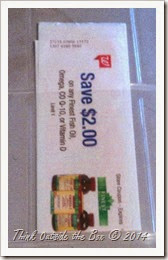
I mentioned last time I put my store coupons in a baseball card holder behind my page protector that holds the store ad. This is an up close look of one of those coupons sitting in the card holder. These would be the coupons I received at checkout. In many coupon policies they allow for store coupons to be used with a manufacture coupon for the same product. This is called “stacking coupons”. You save even more by using them together. I love those kinds of savings. Speaking of savings…majority of the time I only use my coupons when there’s a sale for that particular item. That way I’m not only getting it for the sale price, but I’m saving even more by using coupons with the sale price. You won’t really save much at the store by using coupons alone. Whenever you’re out shopping remember the best way to save is to use those coupons when the items go on sale.
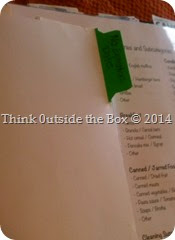
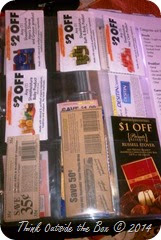
Having categories for all those coupons is a must. Here you see my tab divider for a section I use to store coupons the never expire. In the picture is a baseball card holder with those coupons stored in them. If you look closely you can see that I highlighted the expiration date in order for it to stand out at me.
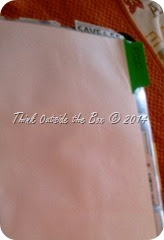
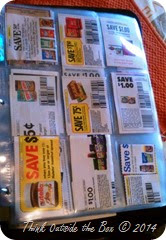
Here I have my tab divider for the food coupons. Behind that are the card holders with coupons in them. I find at times a coupon doesn’t easily fit into a pocket because of its size. Folding it so that the expiration date is showing usually helps. I mentioned last time I wanted to get some photo holders (3 pockets). That would be great to use for storing those oversized or awkward shaped coupons.
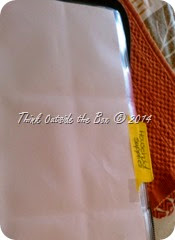
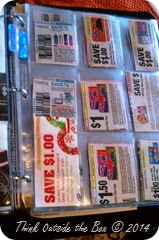
Another example you see here is my "Household Supplies" tab and coupons for those type items. On the left hand bottom side you see a coupon for some paper plates that’s too big. I had to fold it so I could still see the important info. but still able to place it in the pocket. So you see each category gets a tab divider and as many baseball card holders that section needs for the amount of coupons in that category. These are just a few of my many category sections. I plan to redo my sections to match how this lady does hers when I get more page dividers. I like how she uses the plastic dividers verses the paper kind. Those will last much longer. Towards the end of each month I go in and clean out any expired coupons I forgot to take out and move the ones that’s soon to expire in its place. This helps me have room to store more coupons I get.

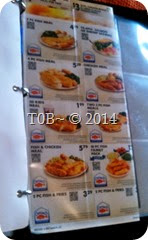
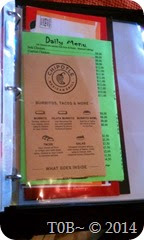
I also wanted to show you this section in the back of my binder. First you see the tab divider for my “Eating Out” section. Next are some coupons that came in the mail that I will cut out and store in the card holders. Last is a page protector where I store menus from places we would like to eat at or get take out food from. This is handy when you want to remember what’s on their menu or their address and phone number.
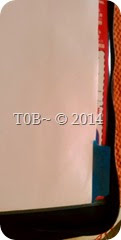
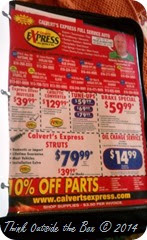
This last part I want to show you is a section for car stuff. I store coupons for repairs and flyers in page protectors for deals off any type maintenance.
Final reminder: Don't let all your hard work go to waist. Take your binder with you every time you go shopping. You never know what kinds of great deals you find. Remember that front section I showed you last time with the big see through (netted) pocket? When I'm out shopping I put the coupons I will be using at checkout in there so that I have them handy to just hand to the cashier before paying for my purchase. This will make getting out of line much quicker. You’ll be glad, the cashier will be glad, and those standing in line behind you will be glad you did. I hope you have enjoyed my coupon binder tutorials and got a better understanding of what it’s all about. For more info. on coupon binders check out some of this website and helpful video:
Frugal Living: How to make a coupon binder
Building a coupon binder
You may be wondering what you need the highlighter for. Many times the expiration date on the manufacture's coupon is hard to see or even find. By highlighting that date you will quickly be able to find it when you need to see if has or about to expire. You don’t want to make the mistake of taking expired coupons to the store and not be able to use it on a good deal you find. Another added benefit is that it’s easy to see through the clear pockets too.
Lets talk about the coupons for a moment. Where are good places to get them? I get mine in the Sunday paper each week. There are different packs like RedPlum, P&G, Smart Source, ect. I have even bought an extra paper just to be able to double on coupons of products I’d like to have more than one of when I come across a good deal. If you know someone who gets the Sunday paper but throws away their coupons, ask and see if they will let you take them off their hands. Other places you can find coupons are store sale ads, magazines, certain sections in the newspaper, inside of or on the front of the package of a product, at the store checkout after paying for your purchase, websites online where you can print them for free, ect. Once I’ve taken all my packs of coupons out of the paper I highlight any coupons that need it and begin cutting them out. I’m not brand specific so I cut out all the coupons for things I know we use or willing to try. Next I separate them into categories so that I can store them in their proper place in my binder. I was happy to have come across an idea of making your own coupon sorting mat. What a neat idea! I will definitely start using this myself.

I mentioned last time I put my store coupons in a baseball card holder behind my page protector that holds the store ad. This is an up close look of one of those coupons sitting in the card holder. These would be the coupons I received at checkout. In many coupon policies they allow for store coupons to be used with a manufacture coupon for the same product. This is called “stacking coupons”. You save even more by using them together. I love those kinds of savings. Speaking of savings…majority of the time I only use my coupons when there’s a sale for that particular item. That way I’m not only getting it for the sale price, but I’m saving even more by using coupons with the sale price. You won’t really save much at the store by using coupons alone. Whenever you’re out shopping remember the best way to save is to use those coupons when the items go on sale.


Having categories for all those coupons is a must. Here you see my tab divider for a section I use to store coupons the never expire. In the picture is a baseball card holder with those coupons stored in them. If you look closely you can see that I highlighted the expiration date in order for it to stand out at me.


Here I have my tab divider for the food coupons. Behind that are the card holders with coupons in them. I find at times a coupon doesn’t easily fit into a pocket because of its size. Folding it so that the expiration date is showing usually helps. I mentioned last time I wanted to get some photo holders (3 pockets). That would be great to use for storing those oversized or awkward shaped coupons.


Another example you see here is my "Household Supplies" tab and coupons for those type items. On the left hand bottom side you see a coupon for some paper plates that’s too big. I had to fold it so I could still see the important info. but still able to place it in the pocket. So you see each category gets a tab divider and as many baseball card holders that section needs for the amount of coupons in that category. These are just a few of my many category sections. I plan to redo my sections to match how this lady does hers when I get more page dividers. I like how she uses the plastic dividers verses the paper kind. Those will last much longer. Towards the end of each month I go in and clean out any expired coupons I forgot to take out and move the ones that’s soon to expire in its place. This helps me have room to store more coupons I get.



I also wanted to show you this section in the back of my binder. First you see the tab divider for my “Eating Out” section. Next are some coupons that came in the mail that I will cut out and store in the card holders. Last is a page protector where I store menus from places we would like to eat at or get take out food from. This is handy when you want to remember what’s on their menu or their address and phone number.


This last part I want to show you is a section for car stuff. I store coupons for repairs and flyers in page protectors for deals off any type maintenance.
Final reminder: Don't let all your hard work go to waist. Take your binder with you every time you go shopping. You never know what kinds of great deals you find. Remember that front section I showed you last time with the big see through (netted) pocket? When I'm out shopping I put the coupons I will be using at checkout in there so that I have them handy to just hand to the cashier before paying for my purchase. This will make getting out of line much quicker. You’ll be glad, the cashier will be glad, and those standing in line behind you will be glad you did. I hope you have enjoyed my coupon binder tutorials and got a better understanding of what it’s all about. For more info. on coupon binders check out some of this website and helpful video:
Frugal Living: How to make a coupon binder
Building a coupon binder
My Coupon Binder Part 2
I hope you enjoyed my last post and got a feel for what I use to carry my coupons around in. Today we will talk about how to set up our binder. This is the part that takes the most time to do but it’s so well worth it. First lets start with a list of supplies you will need.
- Clear sheet protectors
- tab dividers (I plan to buy these kind---will need a 2 or 3 packs)
-Baseball card or photo holders (chose from various sizes offered)
Now we’ll talk about how I make use of these supplies.
First lets talk about sheet protectors. I use them to store things like coupon policies, store sale papers, price list, category list for my coupons (will talk about later), and anything else I use that needs to be in eye view. These are a must have.
Next you will need tab dividers to separate your sections. I use one in between each store, information pages, and coupon sections.
Last you will need baseball card/pocket page protectors. The 9 pocket ones are what I use but I’m thinking of purchasing a small pack of photo holders. These are what you will store your coupons in. (will talk about in the next part).

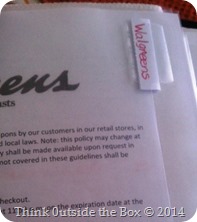
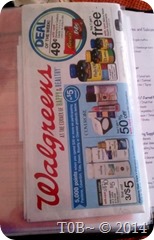
This is an example of my Walgreens section. I have their coupon policy in a page protector as well as their store ad, and a tabbed page divider. Also in this section I may store a baseball card holder page to store coupons or rewards card. Behind this I add another divider for any other drug store types (CVS, Rite Aid, ect.) and a copy of their coupon policy, ect. You can find coupon policies to print by visiting this site.
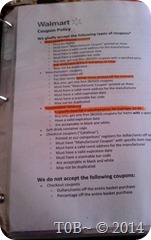
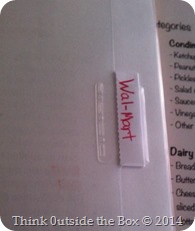
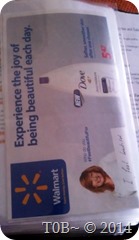
Now we move on to department stores like this one. Just like my Walgreens example I store Wal-Mart's coupon policy in a page protector and have a tab divider page to separate it from others. Behind this I add other department stores (Target, K-mart, ect.) and their coupon policy.
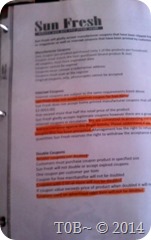
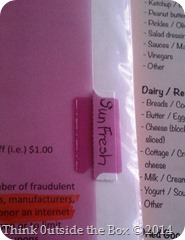
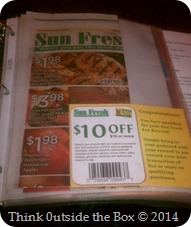
This is one of several grocery stores I shop at. As before I have my Sun Fresh coupon policy, page divider, and their store ad. We got a $10 off my purchase coupon in the mail so I stored it in with the store ad so I wouldn’t forget to use it at the store. Gotta save all you can. Shopping ain’t cheap yall!
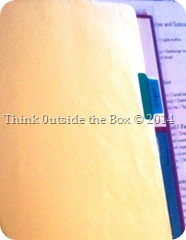
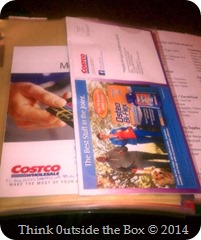
This is my Costco section. I store that month’s coupon book and our membership information in a page protector.
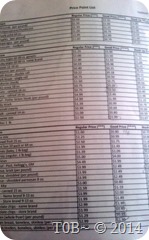
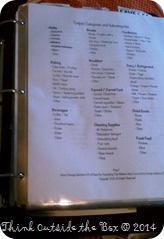
Here are two other helpful items I keep in my binder. The first one is a price list (can no longer find online). It is a list of common items you may purchase at the store often. It shows 3 prices beside each item. They are regular price, a good deal, and stock up prices. You’ll want to aim for the stock up price. It’s the best when using coupons to purchase (will talk about this next time). The other sheet are the coupon categories broken down for easy storing of our coupons in the binder (will tell you about that next time).
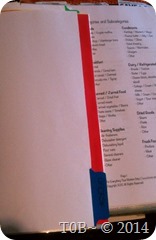

Here is a tabbed section I have for my GFCFSF lists. This is a list of foods you can look for in the store that are gluten free, casein free, and soy free. I got these lists off a yahoo group I used to be a part of. Let me interject with another thought for a moment. I HATE my page dividers. Hubby said he’ll get me whatever I want. I LOVE that man! I’m getting the ones I linked into this post. There I said it now moving on.
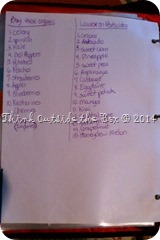
On the back of the divider I wrote a list of foods to buy organic and ones lowest in pesticides. Whew…I hope you understand what I mean buy this taking the most time. It is time consuming to put this thing together but once you have it finished the hard part is done and well worth the time and effort.
Well that’s all I have for today. Come back for the next part where we’ll get into…can you guess? Until then you and your be blessed!
- Clear sheet protectors
- tab dividers (I plan to buy these kind---will need a 2 or 3 packs)
-Baseball card or photo holders (chose from various sizes offered)
Now we’ll talk about how I make use of these supplies.
First lets talk about sheet protectors. I use them to store things like coupon policies, store sale papers, price list, category list for my coupons (will talk about later), and anything else I use that needs to be in eye view. These are a must have.
Next you will need tab dividers to separate your sections. I use one in between each store, information pages, and coupon sections.
Last you will need baseball card/pocket page protectors. The 9 pocket ones are what I use but I’m thinking of purchasing a small pack of photo holders. These are what you will store your coupons in. (will talk about in the next part).



This is an example of my Walgreens section. I have their coupon policy in a page protector as well as their store ad, and a tabbed page divider. Also in this section I may store a baseball card holder page to store coupons or rewards card. Behind this I add another divider for any other drug store types (CVS, Rite Aid, ect.) and a copy of their coupon policy, ect. You can find coupon policies to print by visiting this site.



Now we move on to department stores like this one. Just like my Walgreens example I store Wal-Mart's coupon policy in a page protector and have a tab divider page to separate it from others. Behind this I add other department stores (Target, K-mart, ect.) and their coupon policy.



This is one of several grocery stores I shop at. As before I have my Sun Fresh coupon policy, page divider, and their store ad. We got a $10 off my purchase coupon in the mail so I stored it in with the store ad so I wouldn’t forget to use it at the store. Gotta save all you can. Shopping ain’t cheap yall!


This is my Costco section. I store that month’s coupon book and our membership information in a page protector.


Here are two other helpful items I keep in my binder. The first one is a price list (can no longer find online). It is a list of common items you may purchase at the store often. It shows 3 prices beside each item. They are regular price, a good deal, and stock up prices. You’ll want to aim for the stock up price. It’s the best when using coupons to purchase (will talk about this next time). The other sheet are the coupon categories broken down for easy storing of our coupons in the binder (will tell you about that next time).


Here is a tabbed section I have for my GFCFSF lists. This is a list of foods you can look for in the store that are gluten free, casein free, and soy free. I got these lists off a yahoo group I used to be a part of. Let me interject with another thought for a moment. I HATE my page dividers. Hubby said he’ll get me whatever I want. I LOVE that man! I’m getting the ones I linked into this post. There I said it now moving on.

On the back of the divider I wrote a list of foods to buy organic and ones lowest in pesticides. Whew…I hope you understand what I mean buy this taking the most time. It is time consuming to put this thing together but once you have it finished the hard part is done and well worth the time and effort.
Well that’s all I have for today. Come back for the next part where we’ll get into…can you guess? Until then you and your be blessed!
My Coupon Binder Part 1
Back in 2009 I posted about the new thing I learned about called the coupon binder. I’ve been a dedicated coupon user since before my son was born (over 15 years). I went from carrying coupons in my purse to having coupons in an envelop. I even kept coupons in a small file box (the kind you store recipes in) with each section divided by index cards. I’ve used alphabet and naming specific categories. From there it was the little coupon file holder you carry in your purse but that wasn’t big enough for my growing needs.
I read books on coupon organization and started using a plastic shoe box with a top to store my coupons in. I still was using the index cards to divide the categories and took it with me everywhere I went. The problem with that was some coupons were too big, I didn’t have enough room for my sale circulars or the top coming loose. When it got dropped papers went everywhere and I had to fix it back up again :-( The last thing I tried was a plastic clear square box with a top that locks in place. I thought I would never ever need another coupon system again until I came across the coupon binder system.
I instantly fell in love with the setup. I love anything that has to do with organizing stuff and this was a project I could not pass up. I posted my coupon binder after it was all finished but it was brought to my attention I needed to update it and was asked to do a tutorial. I gladly accepted the challenge. FYI: You won't find that earlier post here because I took it down. Since I have much to cover I decided to break it up into different parts so the post would not be extremely long. That’s why this is part 1. Here are pictures of my binder I’ve been using the last 5 years:
This is what my binder looks like on the outside. I bough it at Walgreens in Sept. 2009 for only $20.
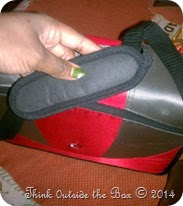
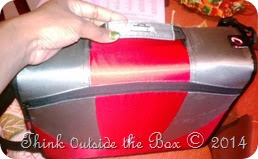
I love that it comes with a padded shoulder strap and a hand held strap to give you more than one way to carry it. When my hands are full I can put it on my shoulders and move right along.
Here is a little zippered pocket on the outside to tuck something small out of the way.
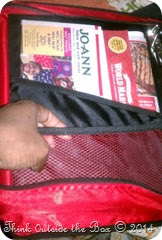
When I open it up this is the first thing you see. There’s a pocket that I use to store some sales papers or my store list. The little netted pocket I use to put the coupons (will cover these later) I’m using to the side so they are handy once I get to the checkout counter.
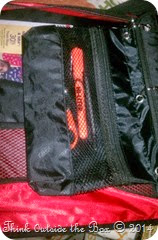 In this pouch I keep my scissors, pen, highlighter (will talk about this later), small pad for your shopping list, and a small calculator (not shown). Keeping these things handy are a must. We are organizing so these are things you will need for things to run smoothly.
In this pouch I keep my scissors, pen, highlighter (will talk about this later), small pad for your shopping list, and a small calculator (not shown). Keeping these things handy are a must. We are organizing so these are things you will need for things to run smoothly.
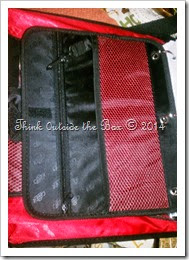
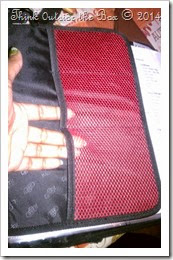
The next thing you’ll see is this part where there’s a place to hold some keys, a zippered compartment, and 3 netted pockets. I use this part to hold things like over-sized coupons, deals, Bed Bath & Beyond coupons or just anything I need a place to store something.
I love the way this binder opens/divides into two sections. I will tell you what’s in each on my next post.
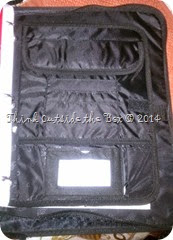
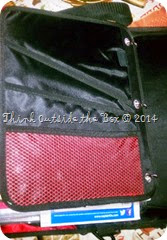
The back of the binder has a Velcro pocket and a place underneath to write your name and phone number on it. This is very important because if you happen to leave it somewhere someone may be nice enough to take it to customer service or contact you to get it back to you. The back side has a pocket and a net one too. Everything can be kept nice and neat with little risk of losing anything. That’s why I love this thing. It has so many compartments to store stuff. You won’t run out of room or places to store things. Now that you’ve seen my binder in part 2 I will get into how I got organized. Hope you come back to see and learn more.
I read books on coupon organization and started using a plastic shoe box with a top to store my coupons in. I still was using the index cards to divide the categories and took it with me everywhere I went. The problem with that was some coupons were too big, I didn’t have enough room for my sale circulars or the top coming loose. When it got dropped papers went everywhere and I had to fix it back up again :-( The last thing I tried was a plastic clear square box with a top that locks in place. I thought I would never ever need another coupon system again until I came across the coupon binder system.
I instantly fell in love with the setup. I love anything that has to do with organizing stuff and this was a project I could not pass up. I posted my coupon binder after it was all finished but it was brought to my attention I needed to update it and was asked to do a tutorial. I gladly accepted the challenge. FYI: You won't find that earlier post here because I took it down. Since I have much to cover I decided to break it up into different parts so the post would not be extremely long. That’s why this is part 1. Here are pictures of my binder I’ve been using the last 5 years:
This is what my binder looks like on the outside. I bough it at Walgreens in Sept. 2009 for only $20.


I love that it comes with a padded shoulder strap and a hand held strap to give you more than one way to carry it. When my hands are full I can put it on my shoulders and move right along.
Here is a little zippered pocket on the outside to tuck something small out of the way.

When I open it up this is the first thing you see. There’s a pocket that I use to store some sales papers or my store list. The little netted pocket I use to put the coupons (will cover these later) I’m using to the side so they are handy once I get to the checkout counter.
 In this pouch I keep my scissors, pen, highlighter (will talk about this later), small pad for your shopping list, and a small calculator (not shown). Keeping these things handy are a must. We are organizing so these are things you will need for things to run smoothly.
In this pouch I keep my scissors, pen, highlighter (will talk about this later), small pad for your shopping list, and a small calculator (not shown). Keeping these things handy are a must. We are organizing so these are things you will need for things to run smoothly.

The next thing you’ll see is this part where there’s a place to hold some keys, a zippered compartment, and 3 netted pockets. I use this part to hold things like over-sized coupons, deals, Bed Bath & Beyond coupons or just anything I need a place to store something.
I love the way this binder opens/divides into two sections. I will tell you what’s in each on my next post.


The back of the binder has a Velcro pocket and a place underneath to write your name and phone number on it. This is very important because if you happen to leave it somewhere someone may be nice enough to take it to customer service or contact you to get it back to you. The back side has a pocket and a net one too. Everything can be kept nice and neat with little risk of losing anything. That’s why I love this thing. It has so many compartments to store stuff. You won’t run out of room or places to store things. Now that you’ve seen my binder in part 2 I will get into how I got organized. Hope you come back to see and learn more.
Monday, October 12
Unstuffed Bell Pepper Casserole
If you like stuffed bell peppers you are sure to love this. Just take your favorite stuffed bell peppers recipe and turn it into a one dish casserole. Here is mine:
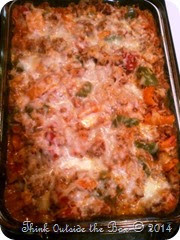 Unstuffed Bell Pepper Casserole
Unstuffed Bell Pepper Casserole
Ingredients:
1 lb. ground beef, turkey, or ground sausage
3 bell peppers, chopped (I used 1 green, 1 orange, and 1 yellow for a pretty Fall look)
1 medium onion, chopped
1-2 garlic cloves, minced (or 1/2 garlic powder)
1/2 cup instant rice or 2 cups cold cooked rice
1/2 cup water (if using instant rice. omit if using cooked rice)
14.5 oz. can stewed tomatoes
1/2 bottle of Heinz chili sauce (here's a good homemade recipe) or use 8 oz. can tomato sauce and 2 Tbsp. Ketchup
1 tsp. Italian Seasoning
1/2 tsp. Sea Salt
1/4 tsp. black pepper
1 tsp. Worcestershire sauce
8 oz. pkg. shredded cheddar cheese (Italian blend or Colby/Monterey Jack would work instead)
Directions:
Preheat oven to 350 degrees. In a pot full of boiling water put in the chopped bell peppers. Let them blanch for 5 minutes then remove them from the water to a strainer. Run cold water over them to stop the cooking. In a skillet brown your meat with the chopped onion until no longer pink. Drain. In a 2qt. casserole dish sprayed with cooking spray. Put in your meat, onions, and bell peppers. If you are using instant rice now is the time to stir that in with the water. If you are using cold cooked rice just put that in. Add in the rest of the seasonings and 1/2 of the cheese and stir. Cover with foil and cook for 30-40 minutes. Uncover, stir, then sprinkle the rest of the cheese on top. Pop back in the oven for 10 minutes or until the cheese is melted. Let sit for 5 minutes before serving.

 Unstuffed Bell Pepper Casserole
Unstuffed Bell Pepper CasseroleIngredients:
1 lb. ground beef, turkey, or ground sausage
3 bell peppers, chopped (I used 1 green, 1 orange, and 1 yellow for a pretty Fall look)
1 medium onion, chopped
1-2 garlic cloves, minced (or 1/2 garlic powder)
1/2 cup instant rice or 2 cups cold cooked rice
1/2 cup water (if using instant rice. omit if using cooked rice)
14.5 oz. can stewed tomatoes
1/2 bottle of Heinz chili sauce (here's a good homemade recipe) or use 8 oz. can tomato sauce and 2 Tbsp. Ketchup
1 tsp. Italian Seasoning
1/2 tsp. Sea Salt
1/4 tsp. black pepper
1 tsp. Worcestershire sauce
8 oz. pkg. shredded cheddar cheese (Italian blend or Colby/Monterey Jack would work instead)
Directions:
Preheat oven to 350 degrees. In a pot full of boiling water put in the chopped bell peppers. Let them blanch for 5 minutes then remove them from the water to a strainer. Run cold water over them to stop the cooking. In a skillet brown your meat with the chopped onion until no longer pink. Drain. In a 2qt. casserole dish sprayed with cooking spray. Put in your meat, onions, and bell peppers. If you are using instant rice now is the time to stir that in with the water. If you are using cold cooked rice just put that in. Add in the rest of the seasonings and 1/2 of the cheese and stir. Cover with foil and cook for 30-40 minutes. Uncover, stir, then sprinkle the rest of the cheese on top. Pop back in the oven for 10 minutes or until the cheese is melted. Let sit for 5 minutes before serving.
Sunday, October 11
And Jesus came and...
Matthew 28:18-20 (KJV)
And Jesus came and spake unto them saying, all power is given unto me in heaven and in earth.
Go ye therefore, and teach all nations, baptizing them in the name of the Father, and of the Son, and of the Holy Ghost:
Teaching them to observe all things whatsoever I have commanded you:
And, lo, I am with you always, even unto the end of the world. Amen
And Jesus came and spake unto them saying, all power is given unto me in heaven and in earth.
Go ye therefore, and teach all nations, baptizing them in the name of the Father, and of the Son, and of the Holy Ghost:
Teaching them to observe all things whatsoever I have commanded you:
And, lo, I am with you always, even unto the end of the world. Amen
Friday, October 9
Homemade Chicken Broth
I recently posted a recipe of my bone broth. I mentioned I do make clear broth sometimes by using skin on/bone in chicken breasts. Well I thought I should come back to share with you how my clear chicken broth looks in case anyone was confused. It’s just like the one you buy at the store in the cans/carton, but I get to control what ingredients is or is not in it.
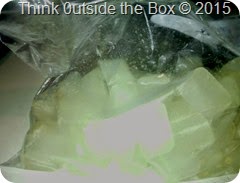 As I stated before I just cook a few bone in/skin on chicken breasts in 6-8 cups of water until done. I take out the pieces of chicken and lay aside to cool down. I strain the broth, pour into big glass canning jars, let cool down, cover, and then refrigerate over night. In the morning I take the jars of broth out and remove the fat off the top layer that has risen. I pour broth into ice cube trays to freeze a few hours or use right away in a dish I’m cooking. Once the broth has frozen I pop out the cubes into 1-2 gallon size (already dated/labeled) Ziploc bags. As for the chicken I pull off the skin and bones and put into a different Ziploc bag I have for used bones and put in freezer to use for a new batch of bone stock. I chop or shred the meat and divide into quart size Ziploc bags to freeze. I love to have these on hand for meals like casseroles, soup, salad, sandwiches, fajitas, tacos, burritos, quesadillas, chicken pizza, buffalo chicken dip, or whatever other uses you can think of. Just think about things you would use canned chicken for. The sky is the limit with what you can do with this.
As I stated before I just cook a few bone in/skin on chicken breasts in 6-8 cups of water until done. I take out the pieces of chicken and lay aside to cool down. I strain the broth, pour into big glass canning jars, let cool down, cover, and then refrigerate over night. In the morning I take the jars of broth out and remove the fat off the top layer that has risen. I pour broth into ice cube trays to freeze a few hours or use right away in a dish I’m cooking. Once the broth has frozen I pop out the cubes into 1-2 gallon size (already dated/labeled) Ziploc bags. As for the chicken I pull off the skin and bones and put into a different Ziploc bag I have for used bones and put in freezer to use for a new batch of bone stock. I chop or shred the meat and divide into quart size Ziploc bags to freeze. I love to have these on hand for meals like casseroles, soup, salad, sandwiches, fajitas, tacos, burritos, quesadillas, chicken pizza, buffalo chicken dip, or whatever other uses you can think of. Just think about things you would use canned chicken for. The sky is the limit with what you can do with this.
Note: You can add veggies like chopped onion, carrots, celery, garlic, and some herbs to your water if you want more flavor, vitamins, and nutrients in your homemade chicken broth. At times I season my broth with a little salt and pepper, but have been known to leave it out since I’m going to season the dish I’m cooking it in. Also note to stock up on chicken breasts when they go on sale for 99 cents a pound. I buy 3-4 family packs just so I can have 1 reserved for making homemade broth and have cooked chicken on hand :-)

 As I stated before I just cook a few bone in/skin on chicken breasts in 6-8 cups of water until done. I take out the pieces of chicken and lay aside to cool down. I strain the broth, pour into big glass canning jars, let cool down, cover, and then refrigerate over night. In the morning I take the jars of broth out and remove the fat off the top layer that has risen. I pour broth into ice cube trays to freeze a few hours or use right away in a dish I’m cooking. Once the broth has frozen I pop out the cubes into 1-2 gallon size (already dated/labeled) Ziploc bags. As for the chicken I pull off the skin and bones and put into a different Ziploc bag I have for used bones and put in freezer to use for a new batch of bone stock. I chop or shred the meat and divide into quart size Ziploc bags to freeze. I love to have these on hand for meals like casseroles, soup, salad, sandwiches, fajitas, tacos, burritos, quesadillas, chicken pizza, buffalo chicken dip, or whatever other uses you can think of. Just think about things you would use canned chicken for. The sky is the limit with what you can do with this.
As I stated before I just cook a few bone in/skin on chicken breasts in 6-8 cups of water until done. I take out the pieces of chicken and lay aside to cool down. I strain the broth, pour into big glass canning jars, let cool down, cover, and then refrigerate over night. In the morning I take the jars of broth out and remove the fat off the top layer that has risen. I pour broth into ice cube trays to freeze a few hours or use right away in a dish I’m cooking. Once the broth has frozen I pop out the cubes into 1-2 gallon size (already dated/labeled) Ziploc bags. As for the chicken I pull off the skin and bones and put into a different Ziploc bag I have for used bones and put in freezer to use for a new batch of bone stock. I chop or shred the meat and divide into quart size Ziploc bags to freeze. I love to have these on hand for meals like casseroles, soup, salad, sandwiches, fajitas, tacos, burritos, quesadillas, chicken pizza, buffalo chicken dip, or whatever other uses you can think of. Just think about things you would use canned chicken for. The sky is the limit with what you can do with this.Note: You can add veggies like chopped onion, carrots, celery, garlic, and some herbs to your water if you want more flavor, vitamins, and nutrients in your homemade chicken broth. At times I season my broth with a little salt and pepper, but have been known to leave it out since I’m going to season the dish I’m cooking it in. Also note to stock up on chicken breasts when they go on sale for 99 cents a pound. I buy 3-4 family packs just so I can have 1 reserved for making homemade broth and have cooked chicken on hand :-)
Homemade Stock aka Bone Broth
Crockpot Homemade Stock (Bone Broth)
Ingredients:
Turkey carcass or 2 chicken carcasses (see note below)
8 cups of cold water (can use more or less)
2 big carrots (unpeeled)
2 celery stalks
1-2 large onions
1 Tbsp. garlic cloves, minced
2 Tbsp. ACV- apple cider vinegar (optional: see note below)
2 Bay leaves (whole)
1 tsp. oregano, basil, or any herb of choice
salt and pepper to taste (optional: see note below)
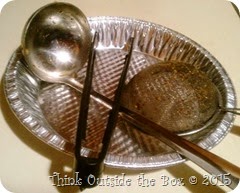 Other supplies: wide mouth canning jars, soup ladle, good size strainer w/handle, and plastic bags from the store (to discard what you strained).
Other supplies: wide mouth canning jars, soup ladle, good size strainer w/handle, and plastic bags from the store (to discard what you strained).Directions:
Wash and cut your veggies into big chunks. No need to peel the carrots. Just wash the outside well. Don’t throw away any of the celery. The leaves and all are good for this recipe. Take the outer skin off the onion and leave the rest on. Leaving these parts on the veggies may sound strange. It’s not a big deal because it will all get strained and discarded once your stock is finished cooking. In a 6 qt. crockpot place your carcass, chopped veggies, herbs, seasonings, and ACV. Pour in your water and cover. Cook on LOW 12 hrs. You can stop here or give a good stir and cook again for another 12 hrs. on LOW. It’s up to you if you want to do 12 or 24 hrs. I’ve done both and was pleased either way. Turn off and let cool down for about 30 minutes before you start handling it.
Sit out a few quart-size Mason jars (or I just use clean jars I have sitting around from something like pasta sauce I bought). I use jars with a wide opening so I can place a wide mouth funnel inside. Now place your hand strainer over the top. With a soup ladle carefully pick up the broth, bones, etc. from the crock pot and pour it into the strainer. I use the strainer to catch the bits and pieces I don’t want falling into my stock. These pieces get dumped into a plastic shopping bag I have handy to throw out. This stuff is still hot so be CAREFUL. Use tongs to pick up the bones if your strainer is small (like mine). Continue until you have enough liquid to fill up one of your jars. Do not fill it all the way up. Leave an inch or two of room (so the fat can rise to the top, which I explain below). Let the jar sit on the counter uncovered to cool down. Once it is no longer piping hot put the lid on and let cool down to room temp so you can put it in the refrigerator. Repeat the steps until you have no more stock left. I let my stock sit overnight in the refrigerator so the fat can rise to the top.
The next morning I open it up, scrap the fat off the top, and put it into a labeled freezer bag (or you could just throw it in the trash) to use as cooking fat. The stock gets put into a set of ice cube trays and I let freeze for a few hours. Once frozen I pop out the cubes and place them into a gallon-sized labeled and dated Ziploc bag. Whenever I need some broth I just use however many cubes I need.
8 cubes = 1 cup of broth.
Note: I stopped buying store-bought broth/stock several years ago. I did not know it was so easy and cheap to make your own. You can make a simple broth with just the meaty bones and water or you can make it more nutritious and flavorful by adding cut up veggies. Making it yourself is healthier because you know what you put in it. During the holidays when I cook a turkey, I never throw away the carcass. I keep it and any bones from other parts of it (legs/wings) in a gallon-size Ziploc bag in the freezer until I’m ready to make bone broth with it. Same process when I cook a whole chicken. I keep the carcass and any other bones in a Ziploc bag. Once we eat a second whole chicken I use them both to make a bone broth. Bones from other meats like Beef, Lamb, or Pork can be used to make broth too so save those bones! Bone broth is great to have on hand to replace water for making soups (especially when someone’s sick), cooked rice, gravies, or anything you need broth for. Now that I make my own I have broth all year long instead of waiting until the holidays to stock up on them when on sale.
Another note: Your stock will look different each time depending on what your bird was seasoned with when cooking it. You may get a lighter-colored or darker-looking stock. Also, I notice my stock tends to be more liquid-looking if I don’t use bones with lots of cartilage as well as the ACV which helps to make it more gelatin-like. I do make a clear broth sometimes by using skin on/bone in chicken breasts. I just cook them in plain water until done. I take out the pieces of chicken and lay aside to cool down. I strain the broth and let it cool to refrigerate or use it right away in a dish I’m cooking. As for the chicken, I pull off the skin and bones and put in a Ziploc bag and freezer to use for a new batch of bone broth/stock. I chop or shred the meat and divide it into quart-size Ziploc bags to use for meals like casseroles, fajitas, tacos, burritos, etc.
Subscribe to:
Posts (Atom)




